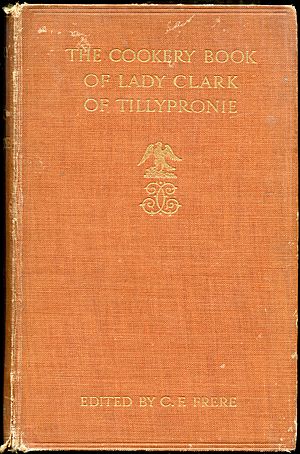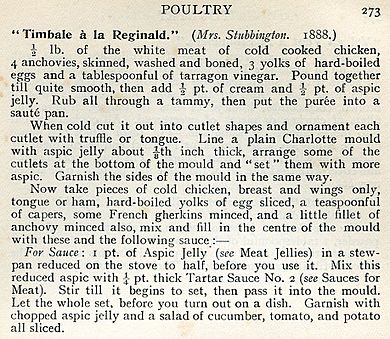The Cookery Book of Lady Clark of Tillypronie facts for kids

First edition
|
|
| Author | Charlotte, Lady Clark Catherine Frances Frere |
|---|---|
| Country | Scotland |
| Subject | 19th century British recipes |
| Genre | Cookery |
| Publisher | Constable & Company |
|
Publication date
|
1909 |
| Pages | xviii + 584 |
The Cookery Book of Lady Clark of Tillypronie is a special collection of recipes. Charlotte, Lady Clark of Tillypronie (1851–1897), gathered these recipes throughout her life. The book was published in 1909, after she had passed away. The oldest recipe in the book is from 1841, and the newest is from 1897.
The artist Catherine Frances Frere helped put the book together. Lady Clark's husband asked her to do this. This book is seen as a very important collection of recipes from the Victorian era. Lady Clark found her recipes by asking friends or cooks for their best dishes. She would then try out each recipe at her home, Tillypronie. She always wrote down who gave her the recipe and often the date.
The book has many traditional British recipes, especially for meat and game. But it also covers other foods like bread, cakes, eggs, and jams. Lady Clark had lived in Italy and France, so the book includes many dishes from these countries. There's even a section called "Curries" for Anglo-Indian cooking. Famous writer Virginia Woolf enjoyed the book, and it inspired the cookery writer Elizabeth David.
Contents
About Lady Clark and Her Book
Tillypronie: Lady Clark's Home
Tillypronie is a large Victorian era house in Scotland. It is located near the Cairngorms National Park. The house overlooks the beautiful valley of the River Dee. Its gardens are open for people to visit. Lady Clark collected thousands of recipes for her own use. She gathered them between 1841 and 1897.
Many important people visited her home. One guest in the 1870s was the writer Henry James. He once wrote that he loved "the old house on the mountain and its genial and bountiful tenants." This shows how welcoming Lady Clark and her husband were.
Lady Clark's Life and Travels
Lady Clark was married to Sir John Forbes Clark. He was a diplomat, which means he worked for his country in other nations. Sir John lived in Paris during the 1848 revolution. He then moved to Brussels in 1852 and Turin, Italy, from 1852 to 1855. He married Charlotte in 1851.
Living in Europe gave Lady Clark a deep understanding of French and Italian cooking. For example, her book has five different recipes for Tartare sauce. She also knew a lot about Anglo-Indian food. This included dishes like "Rabbit Pish-pash."
Her way of collecting recipes was simple but clever. If she tried an interesting dish, she would ask the hostess or cook how it was made. Then, she would go back to Tillypronie and try the recipe herself. This made sure the recipe worked before she wrote it down.
How the Book Was Made
After Lady Clark passed away in 1897, her husband wanted to share her recipes. He asked Catherine Frances Frere (1848–1921) to help. Catherine was the daughter of Sir Henry Bartle Frere. Sir John knew Catherine was interested in cooking and respected his wife's intelligence. He believed the book would help many young women who loved cooking, just like his wife did.
Catherine Frere was born in Bombay, India, in 1848. She had helped publish other cookbooks before. For example, she illustrated her sister Mary's book, Old Deccan Days, Or, Hindoo Fairy Tales Current in Southern India. This book was a collection of folk tales and was very popular. Even though Catherine said she wasn't an expert cook, she was very interested in the "study" of cooking.
Inside the Cookery Book
What's in the Book?
The first edition of the book has 584 pages. It is divided into many sections. These sections cover almost every type of food and cooking method. Here are some of the main parts:
- Baking powder, Barm and Yeast
- Beverages
- Bread, Grissini, Porridge and Rolls
- Cakes, &c.
- Cheeses and cheese dishes
- Confectionery
- Curries
- Domestic Recipes
- Eggs
- Fish
- Fish Pies and Puddings
- Fish, Game, Meat and Savoury Creams
- Game
- Invalid Cookery
- Jams, Jellies, Marmalades, Fruit Syrups, &c.
- Meat
- Meat Jellies
- Meat Pies, Puddings and Soufflés
- Melted Butters, Butter Sauces and Savoury Butters
- Omelets
- Paste and Pastry
- Poultry
- Preserved Fruits
- Roux, Browning and Glaze
- Sauces for Fish
- Sauces for Meat
- Sauces for Poultry and Game
- Sauces for Vegetables
- Soups and Broths
- Stuffings
- Sweet Dishes
- Sweet Puddings
- Sweet Sauces
- Vegetables
The book does not have any pictures inside. At the end, there is an Appendix written by Catherine Frere. It includes advice from the RSPCA on how to treat animals kindly. It also has tips on how to tell if meat is bad. The book finishes with a long index, which helps readers find specific recipes easily.
How Recipes Are Written

Each recipe is written simply. They have a title, and if there are many recipes for the same dish, they are numbered. The recipes do not have a list of ingredients at the start. Instead, they begin right away with instructions. For example, a recipe might start with: "Pound the slightly scalded fish, pound also 1/2 lb. of suet shred very fine, and 2 ozs. of stale bread-crumbs, and 1 egg well beaten."
Many recipes mention the person who shared it, and sometimes the date. For example, "Rhubarb Jam. (Mrs. Davidson, Coldstone Manse. 1886.)"
Some of Lady Clark's recipes are very short. They seem like notes she made for herself. For instance, her recipe for "Vegetable Marrow. No. 3. Stuffed—Turin. 'Cousses'" is very brief. It describes the small marrows and how they are stuffed and served. It even mentions they are sometimes called 'Zucchetti à la Piedmontaise.'
In the book, instructions, ingredients, and comments are all mixed together. The recipes within each section are listed in alphabetical order. Some entries are cross-references. This means they tell you to look somewhere else for a recipe. For example, "'Zucchetti à la Milanaise' and 'à la Piedmontaise.' See Vegetable Marrow."
Different Versions of the Book
For most of the 1900s, there was only one version of the book. This was the original one published in 1909 by Constable:
- Frere, Catherine Frances (editor). (1909) The Cookery Book of Lady Clark of Tillypronie. London: Constable and Company.
However, in the 1990s, a new version was published:
- (1994) The Cookery Book of Lady Clark of Tillypronie, with an Introduction by Geraldene Holt. Lewes: Southover.

